The city lights and the sights had taken its toll. I was by now ready to give my right hand for some peace and quiet. You need peace? Then go to Pokhara! Nobody actually said it. But nevertheless, it seemed a good idea. Pokhara Valley lies close to 200 kilometres to the west of Kathmandu. By road it takes the better part of a day as the roads in Nepal are nothing much to write home about. Flight takes just half an hour and you arrive even before you get to know your pretty flight attendant.
‘The only valley in the world from where you can see mountains higher than 8,000 metres from below 1,000 metres’, read the brochure. I had a car waiting at the airport sent by the hotel to pick me up and I was only glad to escape from the sweltering heat and humidity. Pokhara is the second most popular tourist destination in Nepal. Statistics say that one in every four travellers to the country come to Pokhara on their way to trekking in the Annapurnas. Not so long ago, the 125 sq km valley used to be one big farmland but obviously the lush is slowly giving way to an increasing popularity. Pokhara is situated at an elevation of 900 metres which is quite lower than Kathmandu. This accounts for the generally warmer climate and humidity.Let me quickly run you through some interesting historical highlights of the valley:
1952 – The first airplane landed in Pokhara
1958 – The first jeep arrived by plane
1961 – The first bullock cart arrived (also by plane)
Yes, the primitive wooden bullock cart arrived a full three years late after the jeep
Colourful boats dot the two km long Fewa Lake. Floating along the Fewa is one of the best ways to view the laidback Pokhara. Fishing is done commercially on the Fewa waters as well as for fun. The mountains that silhouetted a bulbous green against the sky, lacing the tranquil waters, revealed a rich flora from close quarters. I floated unmoving, brushing against the eager sprigs, listening to the resigned chirp of a nesting bird and the threatening croak of the rudely awakened water toad.
Looked like Lewis too was here…A boat beneath a sunny sky,
Lingering onward dreamily,
In the evening of July.
Lewis Carroll
The Fewa Lake is popular not just with international tourists but in the domestic circuit also. You find many Nepalis honeymooning, holidaying or just out for a weekend picnic. Tourists can try their luck at angling and the catch will be cooked by your host hotel the way you want it – curried, fried or grilled. As dusk started to descend, I turned my boat around, headed back to land. Towards the eastern side of the lake, there were rows of lodges, restaurants and generally inexpensive accommodation for the backpacker slowly being nudged out of Kathmandu. This side was called the ‘Baidam’ or the Lakeside. A new Freak Street in the making? I couldn’t help but wonder. Or maybe, it already was – going by the revelry and gay abandon that surrounded it. Oblivious to the merriment of the visiting revellers and turning a blind eye towards the romance of just-married couples, stands the Golden Temple of Varahi on a shaded island right in the centre of the lake.
Early next morning, I was back to where I had turned around the previous evening – the foot of the Min Hill, top of which was the World Peace Pagoda. The soul-white structure gleamed beckoningly in the water as me and my local buddy Shiba laboriously oared our boats closer. A tourist landmark, notably among the Buddhists, the Peace Pagoda is something not to be missed for the lovely views of the valley and the surrounding mountains. And of course, for the Buddha, in his meditating nirvana.
The original inhabitants of Pokhara made home near the Fewa Lake. They were mostly from the Khas tribe. Later, during the 18th century, Newars from the Bhaktapur region migrated and settled here forming a sizeable chunk of the population. When the British set up recruitment camps here, the Gurung and Magar communities too resettled in the region. This made the valley a melting pot of cultures in its real sense.
The clouds cleared and I had our first view of the Annapurna range. Standing at a glittering 8,091 metres, the Annapurna I is the crown of the region which is called the Annapurna Himal. With a quiet grunt of satisfaction we reached the top of the hill only to find that two little girls had already reached before us. And they, were not even panting. The peace pagoda is a Buddhist stupa built to unite people of different races and religions in their prayers for world peace. Most of the peace pagodas have been built by Nichidatsu Fujii, a Buddhist monk from Japan. Fujii had a meeting with Mahatma Gandhi in 1931 and was deeply moved by the Mahatma’s teachings on non-violence. He decided to spend the rest of his life spreading the message all over the world. In 1947 he began his endeavour to construct peace pagodas all over the world, the first ones were in Hiroshima and Nagasaki. The foundation for this Peace Pagoda, laid in September 12, 1973, was destroyed. However after much difficulty and negotiation, it was completed on May 21st, 1992. This is one of the 100 peace pagodas all over the world. Around the pagoda is Buddha in four postures – signifying four stages of life. The view of the Fewa Lake and the Pokhara town below was too good from up here to let go. I had to let Shiba pluck me away from the railings and start the journey down.Pokhara had more goodies in store.


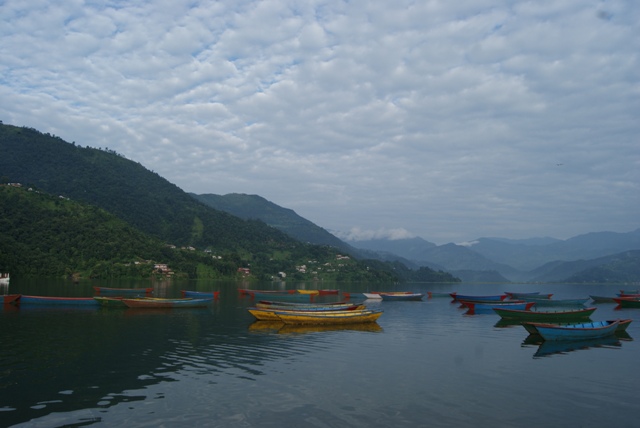
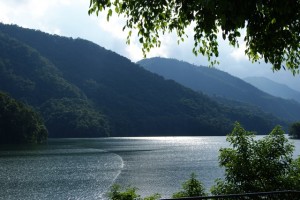
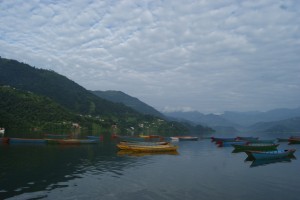
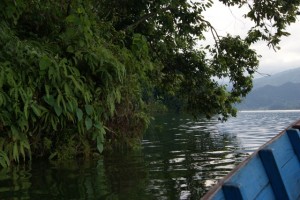
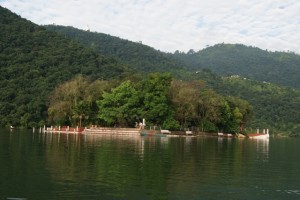
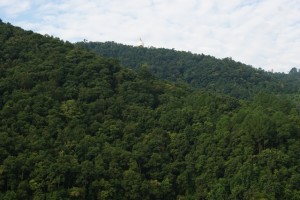
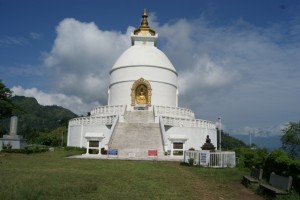









Hi Thommen,
Just stumbled upon your article on Pokhara. I must say that your exuberance is reflected in the article. Yes, driving to Pokhara you will have a wonderful scenery. Flight is more or less weather dependent as mountain weather is quite unpredictable. The colorful boats are called ” doonga” in Nepali.
A perfect article from beginning to end. I will make sure to follow you.
Keep on your good worl.
Cheers:)